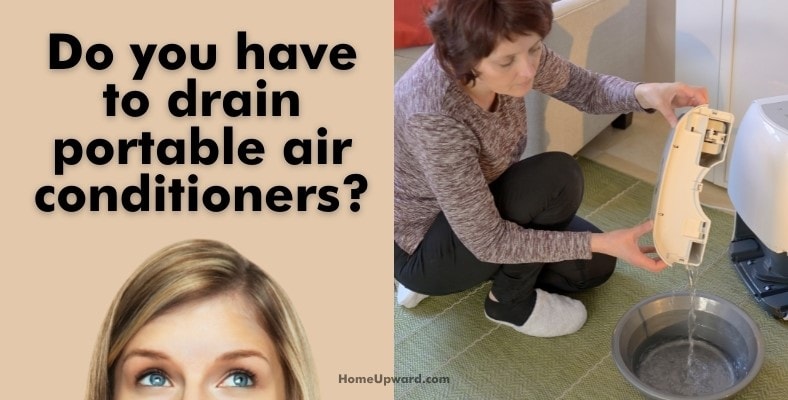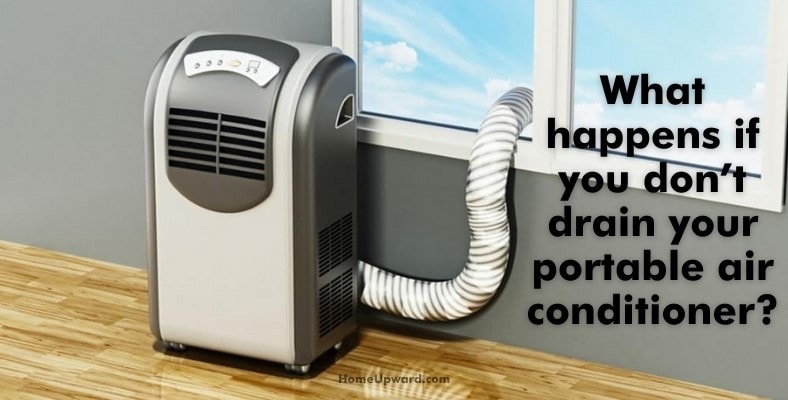If you own a portable air conditioner or intend to buy one, you may be wondering whether they need to be drained or not. Below I’ll explain what you need to know.
Contents
Do you have to drain portable air conditioners?
Portable AC units, as with all air conditioning units, produce condensation. This build-up of water has to go somewhere. However, whether you need to manually drain your portable air conditioner depends on the model.
Many newer units are self-evaporative and vent condensation through an exhaust hose that, in turn, vents hot air. Other models feature a drain plug that sometimes attaches to a hose for draining or into a pan.
Some units may also include a reservoir that needs to be emptied every now and again. That’s why you should consult the user’s manual to find out for sure as well as how to do so.
Portable air conditioning units can alert you when they are full and require draining but that is the point. They will nearly always get to a point when they need to be drained. But this isn’t a must with all models.
Most modern types are low maintenance and many evacuate water in the storage tank by themselves. On some, they may not even require a drain plug because the machine just evaporates the water without any aid. This is due to state-of-the-art self-evaporative technology.
If you have one of these advanced models, you will never need to empty it again. Just be warned as these tend to be on the expensive side of things. If you’re happy with a little bit of draining now and again, the process is surprisingly easy with the majority of AC systems.
To drain an internal water tank, simply:
- Locate a drain pan or bucket. Move the AC unit to an area where it can be drained into a sink.
- Find the drain plug on the rear or side of the AC unit.
- Now, remove the drain plug and rubber stopper. This will begin to drain the water tank.
Once you have removed the drain plug, water will drain freely. It’s as simple as that!
How often should you drain your portable air conditioner?
In most cases, newer portable air conditioners do not need to be drained. Units from EdgeStar, Avallon, and Koldfront use a condensation exhaust system to expel any water vapor that is collected during the cooling or dehumidifying process.
The moisture is then released through the system’s exhaust hose with hot air.
However, you may need to drain your AC unit on certain occasions. When it is extremely humid, water collected during the cooling process isn’t exhausted quickly enough. This can result in water filling the internal reservoir.
On most occasions, the unit will automatically switch off so an overflowing of the internal tank is avoided. Units can display error codes, alarms, or indicate through a light when this occurs. Usually, when this situation happens, you will need to drain the tank, pan, or reservoir.
The rate at which the water collects in the AC’s reservoir, or other parts, can vary significantly. As I mentioned, this usually depends on the air’s humidity.
Other factors that can determine how often you should drain your portable air conditioner include how much the unit is used, the tank’s size, and other weather conditions.
Some units can fill up in only a few hours while others don’t reach maximum capacity for a month or so. Fortunately, just about all portable ACs that feature reservoirs also include a safety feature.
This turns off the unit if the reservoir becomes full. However, you must empty the reservoir before the unit turns back on again. Otherwise, your unit could begin to spill over and leak.
There is no definitive answer as to how frequently you need to drain your portable AC. If you have an older model, you should inspect it frequently and drain any build-up of water that you notice.
If you have a newer model, it should be safe to leave until it alerts you that it needs draining. I recommend regular inspections, in any case, just to be on the safe side.
What happens if you don’t drain your portable air conditioner?
Remember, modern air conditioning units tend to have safety features that automatically shut off the unit if its drainage reservoir becomes too full. However, sometimes the reservoir isn’t full and just contains standing water.
This shouldn’t be an issue as standing water shouldn’t affect the overall function of your unit. As long as it doesn’t overfill and start to leak, a little amount of standing water should be okay.
On the whole, your portable AC unit is probably used regularly. Even when used frequently, standing water shouldn’t be an issue. As long as the unit is drained properly when required, your unit should be good to go for a long time.
However, the same can not be said if you stop using your AC unit altogether for a while.
Standing water can become home to mold and bacteria if left to stagnate for some time. Air conditioning systems can quickly become a brand new breeding ground for such microorganisms. If left alone, these can cause health issues such as allergies and viruses.
If your AC unit has a damp or wet cooling coil, condensate, or humidifier, it is more likely to develop mold and mildew as well. This can release toxins that cause these allergic reactions and even potential diseases.
AC units should be emptied if you don’t plan to use them that regularly. Just simple drainage will limit any chances of bacteria build-up and potential illnesses from occurring.




